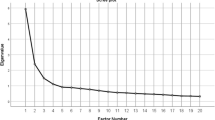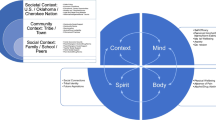Abstract
The Substance Use Risk Profile Scale (SURPS) has been constructed in order to predict substance abuse before it occurs; hence most studies using the SURPS have focussed on adolescents. We examined the SURPS in a Korean and an Australian adult population from each respective country, using a population sampling technique that accurately represented each country. The SURPS was presented as part of an internet survey on alcohol consumption patterns (N = 669), in English and Korean versions. The Korean version was constructed by translating the English version using an accredited technique. We replicated the four-factor structure of the SURPS. Australians scored lower than Koreans on all four sub-scales based on the factors. Australians also scored lower on the total SURPS, and there was a nationality by gender interaction. The total SURPS, but not the subscales, predicted weekly alcohol consumption regardless of nationality. Our results suggest that we have successfully translated the SURPS into Korean, a country that is receiving increasing attention for health research. The relatively high SURPS scores for the Korean sample, along with the increasing popularity of alcohol consumption in that country raises important concerns for social policy developers. The sampling technique utilised also allows the data to be used for normative purposes for future Australian and Korean research. We further suggest that the predictive value of the SURPS applies across a wider group than ‘Western’ adolescents.
Similar content being viewed by others
References
Abramson, L. Y., Metalsky, G. I., & Alloy, L. B. (1989). Hopelessness depression: a theory-based subtype of depression. Psychological review, 96(2), 358.
Brunelle, C., Assaad, J. M., Barrett, S. P., Ávila, C., Conrod, P. J., Tremblay, R. E., et al. (2004). Heightened heart rate response to alcohol intoxication is associated with a reward‐seeking personality profile. Alcoholism: Clinical and Experimental Research, 28(3), 394–401.
Chassin, L., Flora, D. B., & King, K. M. (2004). Trajectories of alcohol and drug use and dependence from adolescence to adulthood: the effects of familial alcoholism and personality. Journal of Abnormal Psychology, 113(4), 483.
Chou, S. P., Lee, H. K., Cho, M. J., Park, J. I., Dawson, D. A., & Grant, B. F. (2012). Alcohol use disorders, nicotine dependence, and co‐occurring mood and anxiety disorders in the United States and South Korea—a cross‐national comparison. Alcoholism: Clinical and Experimental Research, 36(4), 654–662.
Conrod, P. J., Pihl, R. O., Stewart, S. H., & Dongier, M. (2000). Validation of a system of classifying female substance abusers on the basis of personality and motivational risk factors for substance abuse. Psychology of Addictive Behaviors, 14(3), 243.
Conrod, P. J., Castellanos, N., & Mackie, C. (2008). Personality‐targeted interventions delay the growth of adolescent drinking and binge drinking. Journal of Child Psychology and Psychiatry, 49(2), 181–190.
DeHaas, R. A., Calamari, J. E., Bair, J. P., & Martin, E. D. (2001). Anxiety sensitivity and drug or alcohol use in individuals with anxiety and substance use disorders. Addictive Behaviors, 26(6), 787–801.
Ismail, A. C., Seneviratne, R. D. A., Newcombe, P. A., & Wanigaratne, S. (2009). A model of substance abuse risk adapting to the Sri Lankan context. Evaluation Review, 33(1), 83–97.
Krank, M., Stewart, S. H., O’Connor, R., Woicik, P. B., Wall, A.-M., & Conrod, P. J. (2011). Structural, concurrent, and predictive validity of the Substance Use Risk Profile Scale in early adolescence. Addictive Behaviors, 36(1), 37–46.
Littlefield, A. K., Sher, K. J., & Steinley, D. (2010). Developmental trajectories of impulsivity and their association with alcohol use and related outcomes during emerging and young adulthood I. Alcoholism: Clinical and Experimental Research, 34(8), 1409–1416.
Luengo, M., Carrillo-De-La-Pena, M., Otero, J., & Romero, E. (1994). A short-term longitudinal study of impulsivity and antisocial behavior. Journal of Personality and Social Psychology, 66(3), 542.
Malmberg, M., Overbeek, G., Monshouwer, K., Lammers, J., Vollebergh, W. A., & Engels, R. C. (2010). Substance use risk profiles and associations with early substance use in adolescence. Journal of Behavioral Medicine, 33(6), 474–485.
Mohlman, J., & Zinbarg, R. E. (2000). The structure and correlates of anxiety sensitivity in older adults. Psychological Assessment, 12(4), 440.
Moran, C. C., & Saliba, A. J. (2012). Reasons for drinking wine and other beverages–comparison across motives in older adults. International Journal of Wine Research, 4, 25–32.
Mushquash, C. J., Comeau, M. N., & Stewart, S. H. (2007). An alcohol abuse early intervention approach with Mi’kmaq adolescents. The First Peoples Child and Family Review, 3, 17–26.
Norton, G. R. (2001). Substance use/abuse and anxiety sensitivity: what are the relationships? Addictive Behaviors, 26(6), 935–946.
Park, S., & Kim, H. (2008). Relationships between parental alcohol abuse and social support, peer substance abuse risk and social support, and substance abuse risk among South Korean adolescents. Adolescence, 44(173), 87–99.
Reiss, S., Peterson, R. A., Gursky, D. M., & McNally, R. J. (1986). Anxiety sensitivity, anxiety frequency and the prediction of fearfulness. Behaviour Research and Therapy, 24(1), 1–8.
Ronel, N., & Levy-Cahana, M. (2011). Growing-up with a substance-dependent parent: development of subjective risk and protective factors. Substance Use & Misuse, 46(5), 608–619.
Saliba, A. J., & Moran, C. C. (2010). The influence of perceived healthiness on wine consumption patterns. Food Quality and Preference, 21(7), 692–696.
Schlauch, R. C. (2010). Validation Of The Substance Use Risk Profile Scale (SURPS) in treatment-seeking substance abusers using cue reactivity methodology. Electronic Theses, Treatises and Dissertations. Paper 2012. http://diginole.lib.fsu.edu/etd/2012.
Sharpe, D. L., Abdel-Ghany, M., Kim, H.-Y., & Hong, G.-S. (2001). Alcohol consumption decisions in Korea. Journal of Family and Economic Issues, 22(1), 7–24.
Siu, A. F. (2011). Validation of the substance use risk profile scale for adolescents in Hong Kong. Journal of Psychoeducational Assessment, 29(1), 75–83.
Stewart, S. H., McGonnell, M., Wekerle, C., & Adlaf, E. (2011). Associations of personality with alcohol use behaviour and alcohol problems in adolescents receiving child welfare services. International Journal of Mental Health and Addiction, 9(5), 492–506.
Sung, J., Lee, K., Song, Y.-M., & Kim, J.-H. (2011). Relationships between state and trait anxiety inventory and alcohol use disorder identification test scores among Korean twins and families: the healthy twin study. Twin Research and Human Genetics, 14(01), 73–78.
Woicik, P. A., Stewart, S. H., Pihl, R. O., & Conrod, P. J. (2009). The Substance Use Risk Profile Scale: a scale measuring traits linked to reinforcement-specific substance use profiles. Addictive Behaviors, 34(12), 1042–1055.
World Health Organisation. (2008). Preventing alcohol-related harm in Australia: a window of opportunity. from http://www.health.gov.au/internet/preventativehealth/publishing.nsf/Content/tech-alcohol-toc~tech-alcohol-2~tech-alcohol-2.1.
Zuckerman, M., & Kuhlman, D. M. (2000). Personality and risk‐taking: common bisocial factors. Journal of Personality, 68(6), 999–1029.
Author information
Authors and Affiliations
Corresponding author
Rights and permissions
About this article
Cite this article
Saliba, A.J., Moran, C. & Yoo, Y. The Substance Use Risk Profile Scale: Comparison of Norms and Outcomes for Australian and Korean Adults. Int J Ment Health Addiction 12, 538–547 (2014). https://doi.org/10.1007/s11469-014-9490-5
Published:
Issue Date:
DOI: https://doi.org/10.1007/s11469-014-9490-5




